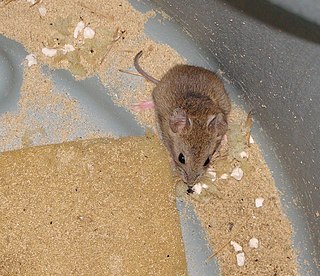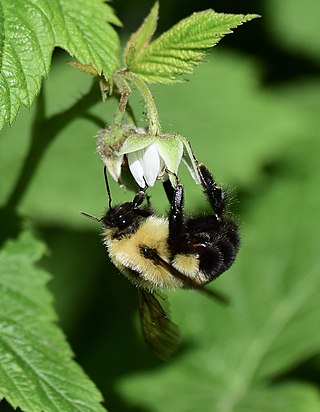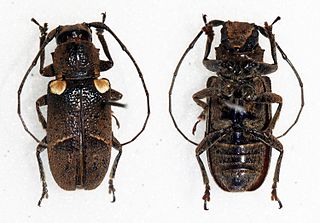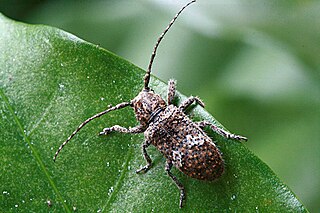
The California two-spot octopus, often simply called a "bimac", is an octopus species native to many parts of the Pacific Ocean including the coast of California. One can identify the species by the circular blue eyespots on each side of its head. Bimacs usually live to be about two years old. They are closely related to Verrill's two-spot octopus. In 2015, the genome was sequenced.

Gryllus bimaculatus is a species of cricket in the subfamily Gryllinae. Most commonly known as the two-spotted cricket, it has also been called the "African" or "Mediterranean field cricket", although its recorded distribution also includes much of Asia, including China and Indochina through to Borneo. It can be discriminated from other Gryllus species by the two dot-like marks on the base of its wings.

Vesper mice are rodents belonging to the genus Calomys. They are widely distributed in South America. Some species are notable as the vectors of Argentinian hemorrhagic fever and Bolivian hemorrhagic fever.
Platymantis bimaculatus is a species of frog in the family Ceratobatrachidae. It is endemic to West Papua, Indonesia.

The African jewelfish, also known as jewel cichlid or jewelfish, is from the family Cichlidae.

Ecsenius bimaculatus, known commonly as the twinspot coralblenny, is a species of marine fish in the family Blenniidae.

The twospot hogfish is a species of wrasse native to the Indo-Pacific from Madagascar to New Caledonia and from Japan to New Zealand. This species prefers areas of reefs with substrates of rubble or sand at depths from 30 to 60 m. This species can reach a length of 10 cm (3.9 in). It can be found in the aquarium trade.

The two-spotted bumble bee is a species of social bumble bee found in the eastern half of the United States and the adjacent south-eastern part of Canada. In older literature this bee is often referred to as Bremus bimaculatus, Bremus being a synonym for Bombus. The bee's common name comes from the two yellow spots on its abdomen. Unlike many of the other species of bee in the genus Bombus,B. bimaculatus is not on the decline, but instead is very stable. They are abundant pollinators that forage at a variety of plants.

Ompok bimaculatus, known as butter catfish, is a species of sheatfishes native to Asian countries such as Bangladesh, India, Pakistan, and Sri Lanka, but recently identified in Myanmar. It also indetified in Mekong Basin of Vietnam

Prosoplus is a genus of longhorn beetles of the subfamily Lamiinae, containing the following species:
Apicystis is a genus of parasitic alveolates of the phylum Apicomplexa.
The Moluccan monarch is a species of bird in the family Monarchidae. It is found in Indonesia. Its natural habitats are subtropical or tropical moist lowland forests and subtropical or tropical moist montane forests.
Prosoplus atlanticus is a species of beetle in the family Cerambycidae. It was described by Stephan von Breuning in 1938.

Rhytiphora bankii is a species of beetle in the family Cerambycidae. It was first described by Johan Christian Fabricius in 1775, under the genus Lamia. It is known from Australia, the Philippines, Borneo, Java, Micronesia, New Guinea, Hawaii, Moluccas, Sumatra, Vietnam, and has been introduced into Japan. The Australian species of Prosoplus were synonymised with Rhytiphora in 2013.
Prosoplus costatus is a species of beetle in the family Cerambycidae. It was described by Karl-Ernst Hüdepohl in 1996. It is known from Borneo and Malaysia.
Prosoplus dentatus is a species of beetle in the family Cerambycidae. It was described by Guillaume-Antoine Olivier in 1792. It is known from Mauritius, Seychelles, Réunion, and Madagascar. It contains the varietas Prosoplus dentatus var. ochreomaculatus.
Prosoplus lividus is a species of beetle in the family Cerambycidae. It was described by Masaki Matsushita in 1935.
Prosoplus sinuatofasciatus is a species of beetle in the family Cerambycidae. It was described by Blanchard in 1855.

Melissodes bimaculatus, the two-spotted longhorn, is a species of long-horned bee in the family Apidae.

Octopus bimaculatus, commonly referred to as Verrill's two-spot octopus, is a similar species to the Octopus bimaculoides, a species it is often mistaken for. The two can be distinguished by the difference in the blue and black chain-like pattern of the ocelli. O. bimaculatus hunt and feed on a diverse number of benthic organisms that also reside off the coast of Southern California. Once the octopus reaches sexual maturity, it shortly dies after mating, which is approximately 12–18 months after hatching. Embryonic development tends to be rapid due to this short lifespan of these organisms.












